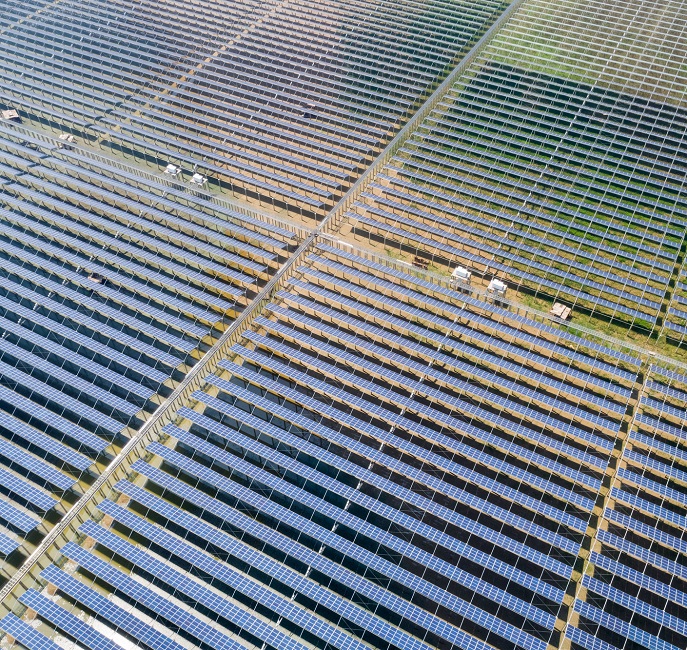Invenergy equips solar services teams for 3 GW growth push
Invenergy is developing in-house analytics to accelerate growth in solar services and predicts more complex roles and wider technology knowledge within maintenance teams, Brad Purtell, Director, Services Business Development at Invenergy, told New Energy Update.

Related Articles
As U.S. solar costs fall and installations surge, developers are expanding operations and maintenance (O&M) divisions to gain a competitive edge.
Utility-scale installations are forecast to hit a record level of 12.6 GW in 2020, the U.S. Solar Energy Industry Association (SEIA) and Wood Mackenzie Power and Renewables said in their latest quarterly market report.
Some 8.7 GW of utility-scale PV is currently under construction and an additional 29 GW of projects are scheduled to come online in the next several years, the report said.
US PV installation forecast
(Click image to enlarge)
Source: Wood Mackenzie Power and Renewables, September 2019
As fleet sizes grow, operators are seeking new analytics and technology solutions to maximize economies of scale. Advanced monitoring and data analytics allows solar operators to pinpoint faults and implement predictive and preventative maintenance strategies.
Invenergy, the U.S.' largest privately-held renewable energy operator, is developing analytics in-house to support rapid growth in the services sector, Purtell told New Energy Update.
Invenergy currently operates 330 MW of U.S. solar and 5.6 GW of wind capacity and plans to expand its solar operations portfolio to 3 GW within the "next few years," he said.
As analytics boosts the performance of growing fleets, the roles of O&M teams will evolve, Purtell said.
Engineers and technicians will need to adapt to an expanding technology and component landscape and greater project complexity to maximize gains, he said.
Bespoke programs
Invenergy's O&M activities are based on a "robust feedback loop" between its Engineering, Invenergy Control Center and Field Service teams, Purtell said. Performance engineers use SCADA data and analytics programs written in MATLAB and Pythoncreate to create work orders for field crews.
The analytics programs have reduced labor costs for solar plant by cutting the number of manual inspections, Purtell said.
Analytics helps to narrow down plant issues to a "subcomponent" level before the site visit, enabling maintenance teams to source the correct subcomponent and avoid multiple trips, he said.
Operators are also combining analytics with more centralized spare parts facilities to gain greater control of supply risks.
To further increase efficiency, Invenergy has developed its own proprietary analytics to tackle specific performance issues for solar farms.
In one example, the group has used analytics to review tracker system parameters to minimize panel-to panel shading as it changes throughout the day, Purtell said.
Invenergy performed iterative testing to optimize panel angles during key early morning and late afternoon periods, maximizing energy output for the whole solar farm, he said.
The company also developed analytics to optimize inverter settings that were impacting output.
"Software optimization is a great low-cost opportunity for performance enhancement, especially for utility-scale solar projects," Purtell said.
Tech trials
Large development pipelines allow operators to test the latest O&M technologies on the market.
Solar technology innovations have greatly improved technician utilization ratios over the last few years, Leila Garcia da Fonseca, Wood Mackenzie Principal Analyst, said in a research note earlier this month.
"Previously, one technician would be able to service 20 MW of solar capacity. Global downward price pressures have driven the implementation of automated solutions and digital platforms, making it possible for technicians to service from 40 MW to 60 MW of solar capacity," Fonseca said.
US solar O&M costs by category (2018)

Source: National Renewable Energy Laboratory.
Invenergy is among a growing group of operators deploying drones and advanced imaging technologies at solar sites to detect faults and cut inspection times. Operators such as Duke Energy and Enel Green Power are combining drones with artificial intelligence (AI) to provide automated maintenance insights.
"Drones have a strong use case because of the lack of granular data provided by solar equipment manufacturers. Drones with infrared cameras allow for easy detection of underperformance," Purtell said.
New panel coating solutions are set to reduce soiling risks and some companies are starting to use remote-cleaning devices to reduce labor costs.
Invenergy has trialed remote-cleaning technologies and is currently evaluating whether they can be deployed economically, Purtell said.
Growing skillsets
While Invenergy will continue to evaluate machine learning solutions and other advanced technologies, engineers will "remain critical" to the group's O&M processes, Purtell said.
As portfolios grow and the range of technology widens, O&M teams will need to expand their knowledge of different component brands, he noted.
Invenergy plans to expand its capabilities on a "multitude" of tracker systems, inverters, panel technologies, and plant controllers, he said.
Invenergy is also an early mover in bifacial solar development and plans to bring online its first 160 MW bifacial solar plant in Georgia later this year. Bifacial plants require greater focus on vegetation management and albedo (ground-reflectance) to maximize output.
Solar O&M roles will become more complex as new technologies displace older parts, Purtell said.
"O&M teams will be required to continue to learn new systems, while simultaneously maintaining legacy systems," he said.
As project and fleet sizes grow, standardization of practices will help to optimize staff deployment.
The growing importance of analytics will require O&M teams to communicate in a variety of mediums, Purtell said.
Technicians will need to be able to articulate their findings in the field "to strengthen the feedback loop" for continual improvements, he said.
New Energy Update

